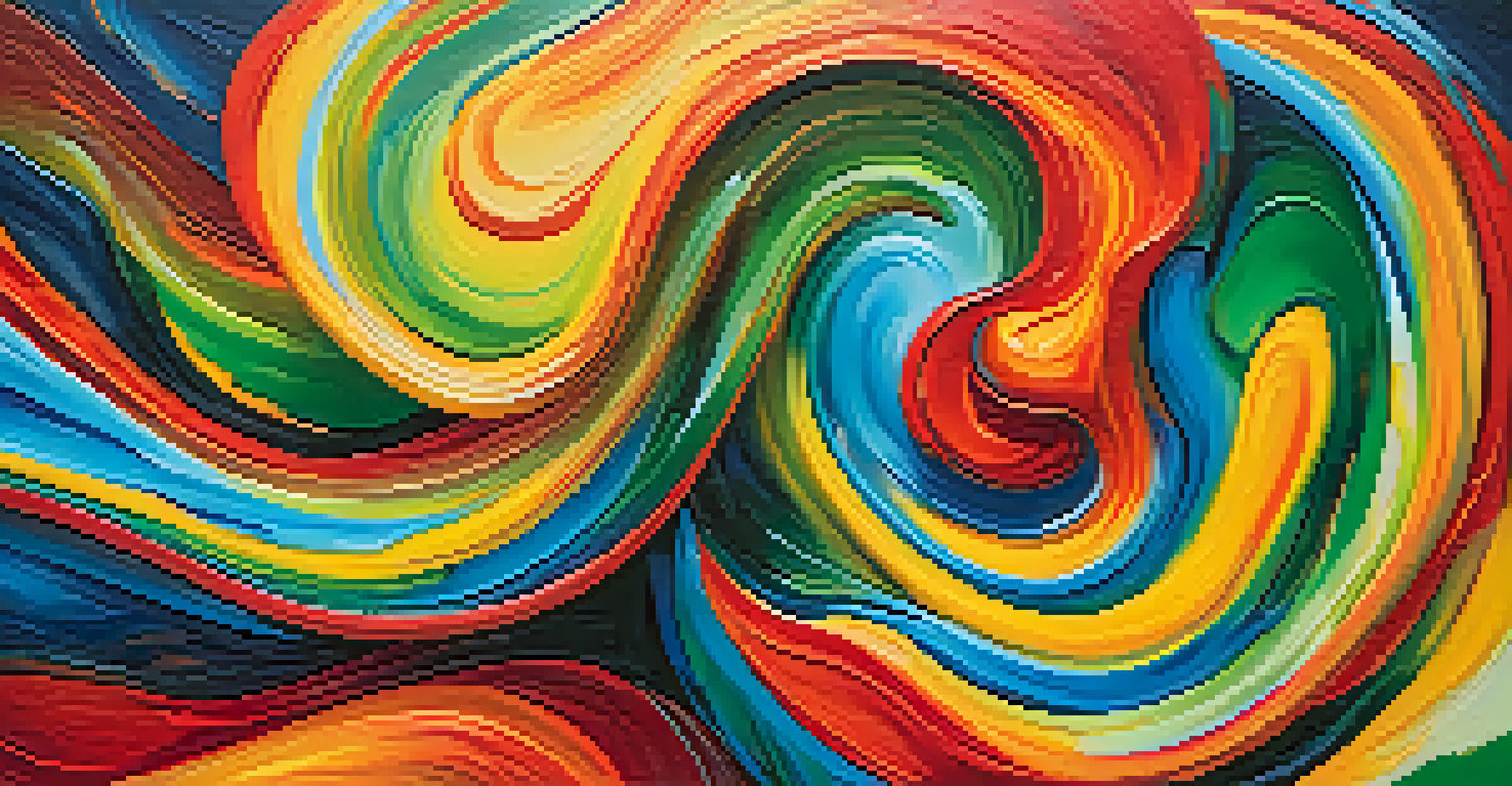Exploring Artistic Mediums: Their Emotional Effects on Viewers

The Power of Color: How Hues Influence Emotions
Color has a profound impact on our emotions, acting like a universal language that transcends words. For instance, warm colors like red and orange can evoke feelings of warmth and passion, while cool colors like blue and green tend to bring about calmness and tranquility. Artists often use these colors intentionally to guide viewers' emotional journeys through their work.
Color is the keyboard, the eyes are the harmonies, the soul is the piano with many strings.
Consider the famous painting 'The Starry Night' by Vincent van Gogh. The swirling blues and bright yellows create a sense of movement and energy, encapsulating the viewer in a whirlwind of emotions. This demonstrates how artists manipulate color to communicate feelings that resonate deeply with audiences.
Understanding the emotional power of color can enhance our appreciation of art, allowing us to connect with the piece on a more personal level. By recognizing how color influences our mood, we can begin to explore our own feelings and reactions to various artworks.
Texture and Form: Engaging the Senses Beyond Sight
Texture in art adds a tactile dimension that can evoke physical and emotional reactions in viewers. For example, a rough, jagged texture might instill feelings of discomfort or chaos, while a smooth, soft texture can create sensations of warmth and comfort. This sensory experience can make a piece of art more relatable and impactful.

Take, for example, a sculpture carved from rough stone versus one made from polished marble. The former may convey strength and raw emotion, while the latter may evoke elegance and refinement. These contrasting textures can engage viewers in different ways, leading to varied emotional responses.
Color Shapes Our Emotions
Different colors evoke distinct emotional responses, influencing how we connect with art.
By exploring texture and form, we can deepen our understanding of how artists communicate feelings through their work. This exploration encourages us to interact with art on multiple sensory levels, enriching our overall experience.
Medium Matters: The Impact of Different Artistic Practices
The choice of medium—be it oil, watercolor, or digital—can significantly shape the emotional tone of a piece. Each medium has its unique characteristics that can either enhance or diminish the emotional message an artist intends to convey. For instance, watercolor can evoke a sense of delicacy and fluidity, while oil paint often allows for richer, bolder color applications.
Art is the most beautiful of all lies; it is a way to see the world through the artist's eyes.
Consider how a landscape painted in soft pastels may bring about a sense of calmness and serenity, while a vibrant acrylic piece may evoke excitement and energy. The medium itself becomes a crucial player in the emotional narrative of the artwork.
Understanding the relationship between medium and emotion allows viewers to appreciate the artist's choices more fully. It invites us to reflect on how different materials can alter our perceptions and feelings toward a piece of art.
Narrative Art: Storytelling That Moves Us
Narrative art tells stories, often drawing viewers into emotional journeys that resonate with their own experiences. When we encounter a painting or sculpture that depicts a scene, we instinctively look for the story behind it. This storytelling aspect can evoke empathy, nostalgia, or even joy, depending on the narrative being portrayed.
A great example is Picasso's 'Guernica,' which powerfully conveys the anguish of war through its chaotic composition and stark imagery. Viewers are compelled to confront the emotions represented in the piece, sparking discussions about conflict and humanity.
Texture Enhances Emotional Impact
The texture of an artwork can create tactile sensations that deepen our emotional reactions.
By engaging with narrative art, we not only explore the artist's intention but also reflect on our own personal narratives. This connection fosters a deeper emotional understanding and appreciation for the artwork.
Cultural Context: Emotions Through a Historical Lens
The cultural context of an artwork plays a significant role in shaping its emotional impact. Art is often a reflection of societal values, beliefs, and historical moments, which can enhance or alter the viewer's emotional response. Understanding the background of a piece can provide deeper insight into its emotional weight.
For instance, traditional African masks often carry deep spiritual meanings, evoking feelings of reverence and connection to ancestry. In contrast, contemporary art movements might explore themes of identity and social justice, prompting viewers to confront their own beliefs and emotions.
By appreciating the cultural context, we can better grasp the multifaceted emotions that art can evoke. This awareness invites us to engage with art on a more profound level, recognizing the layers of meaning embedded within.
The Role of the Viewer: Personal Interpretation and Emotion
Every viewer brings their own experiences, emotions, and interpretations to a piece of art, creating a unique connection that can be incredibly powerful. Art is not just a static object; it becomes a living dialogue between the artist and the audience. This interaction shapes how we perceive and feel about what we see.
For example, a painting depicting a serene landscape may evoke feelings of peace in one viewer, while another might feel a sense of longing or nostalgia. This subjective nature of art underscores the importance of personal interpretation in the emotional experience.
Personal Interpretation Matters
Each viewer's unique experiences shape their emotional connection to art, making interpretation a personal journey.
Recognizing that our emotional responses to art are valid and significant encourages us to explore our feelings openly. This personal connection can deepen our appreciation for the artwork and enhance our understanding of ourselves.
Final Thoughts: The Lasting Impact of Artistic Expression
Artistic expression has the remarkable ability to evoke deep emotions, prompting self-reflection and connection. As we explore different mediums, textures, and narratives, we uncover the complex ways art influences our feelings. This journey through art not only enriches our lives but also fosters empathy and understanding.
Whether it's the vibrant colors of a painting or the haunting tones of a sculpture, each piece invites us to engage with our emotions in unique ways. The emotional effects of art can linger long after we've stepped away from the canvas, leaving us with insights and reflections.

Ultimately, exploring the emotional effects of artistic mediums encourages us to embrace our feelings and recognize the power of art to connect us all. It’s a reminder that art is not just something to be admired; it’s a profound avenue for emotional exploration and growth.